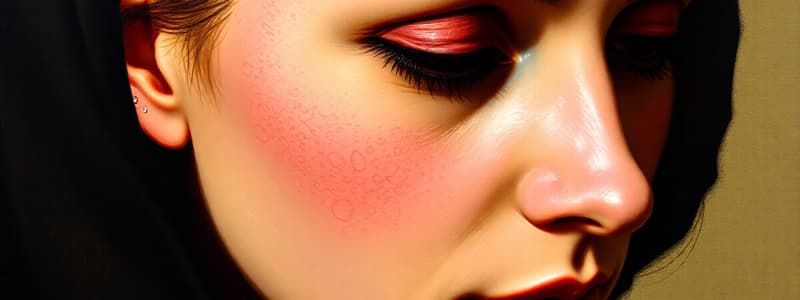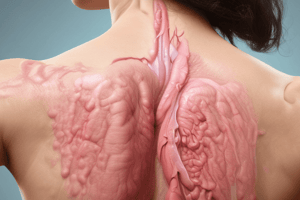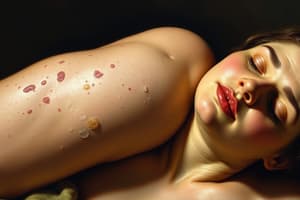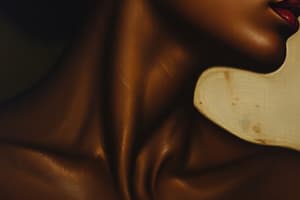Podcast
Questions and Answers
Which of the following factors is NOT typically associated with the development of acanthosis nigricans?
Which of the following factors is NOT typically associated with the development of acanthosis nigricans?
- Endocrine disorders
- Obesity
- Exposure to ultraviolet radiation (correct)
- Use of topical corticosteroids
What is a common characteristic of seborrheic keratosis?
What is a common characteristic of seborrheic keratosis?
- It typically appears as a flat, smooth patch of skin.
- It is usually very painful and itchy.
- It is most frequently found on the palms and soles.
- It often has a "stuck-on" appearance. (correct)
What is the most common benign epithelial tumor?
What is the most common benign epithelial tumor?
- Seborrheic keratosis (correct)
- Acanthosis nigricans
- Cherry angioma
- Actinic keratosis
Which of the following is a potential treatment option for acanthosis nigricans?
Which of the following is a potential treatment option for acanthosis nigricans?
In what age group is seborrheic keratosis rarely seen?
In what age group is seborrheic keratosis rarely seen?
Which of the following is a characteristic of alopecia areata?
Which of the following is a characteristic of alopecia areata?
What is the most common cause of telogen effluvium?
What is the most common cause of telogen effluvium?
Which of the following is NOT a possible treatment option for alopecia areata ?
Which of the following is NOT a possible treatment option for alopecia areata ?
What is the characteristic hair finding associated with alopecia areata?
What is the characteristic hair finding associated with alopecia areata?
What is the primary treatment for telogen effluvium?
What is the primary treatment for telogen effluvium?
What is the most common type of alopecia?
What is the most common type of alopecia?
Which of the following is NOT a possible cause of scarring alopecia?
Which of the following is NOT a possible cause of scarring alopecia?
Which of the following is a systemic symptom that may occur with a Loxosceles spider bite?
Which of the following is a systemic symptom that may occur with a Loxosceles spider bite?
What is the typical treatment for a Latrodectus spider bite?
What is the typical treatment for a Latrodectus spider bite?
What is the typical timeframe for the resolution of pain associated with a Latrodectus spider bite?
What is the typical timeframe for the resolution of pain associated with a Latrodectus spider bite?
What is the typical timeframe for the development of the depressed center in a Loxosceles spider bite?
What is the typical timeframe for the development of the depressed center in a Loxosceles spider bite?
What is the typical timeframe for the resolution of a Loxosceles spider bite?
What is the typical timeframe for the resolution of a Loxosceles spider bite?
What is the typical location of a Loxosceles spider bite?
What is the typical location of a Loxosceles spider bite?
Which of the following is NOT a typical symptom of a fungal infection of the fingernails or toenails?
Which of the following is NOT a typical symptom of a fungal infection of the fingernails or toenails?
What is the recommended treatment duration for toenail onychomycosis using oral terbinafine?
What is the recommended treatment duration for toenail onychomycosis using oral terbinafine?
Which of the following is a common risk factor for paronychia?
Which of the following is a common risk factor for paronychia?
Which of the following medications is NOT recommended for the treatment of onychomycosis due to its potential for hepatotoxicity?
Which of the following medications is NOT recommended for the treatment of onychomycosis due to its potential for hepatotoxicity?
What is the recommended monitoring schedule for liver function tests (LFTs) and complete blood count (CBC) while a patient is taking oral antifungal medications for dermatophytosis?
What is the recommended monitoring schedule for liver function tests (LFTs) and complete blood count (CBC) while a patient is taking oral antifungal medications for dermatophytosis?
Which of the following is a common symptom of tinea corporis?
Which of the following is a common symptom of tinea corporis?
Which of the following topical antifungal medications is available over-the-counter?
Which of the following topical antifungal medications is available over-the-counter?
What is the name of the fungal infection that affects the scalp hair?
What is the name of the fungal infection that affects the scalp hair?
Which of these medications is specifically used to treat scabies?
Which of these medications is specifically used to treat scabies?
In what age group should Elimite (Permethrin) not be used to treat scabies?
In what age group should Elimite (Permethrin) not be used to treat scabies?
What is the recommended treatment frequency for Ivermectin in cases of severe scabies?
What is the recommended treatment frequency for Ivermectin in cases of severe scabies?
What is the primary symptom of scabies?
What is the primary symptom of scabies?
What is the most common site of scabies in adults?
What is the most common site of scabies in adults?
What is the characteristic appearance of tinea versicolor on microscopic examination?
What is the characteristic appearance of tinea versicolor on microscopic examination?
What is a common treatment for molluscum contagiosum?
What is a common treatment for molluscum contagiosum?
Which of the following conditions is primarily associated with HPV 6 and HPV 11?
Which of the following conditions is primarily associated with HPV 6 and HPV 11?
What is a hallmark symptom of genital herpes caused by HSV-2?
What is a hallmark symptom of genital herpes caused by HSV-2?
Which organism is responsible for tinea versicolor?
Which organism is responsible for tinea versicolor?
What is a significant risk factor for developing herpes zoster (shingles)?
What is a significant risk factor for developing herpes zoster (shingles)?
What population typically shows more severe disease from chickenpox (varicella)?
What population typically shows more severe disease from chickenpox (varicella)?
What is the treatment of choice for cutaneous candidiasis?
What is the treatment of choice for cutaneous candidiasis?
Which of the following skin conditions is characterized by 'spaghetti and meatballs' appearance on microscopy?
Which of the following skin conditions is characterized by 'spaghetti and meatballs' appearance on microscopy?
Which treatment option is typically not recommended for genital candidiasis?
Which treatment option is typically not recommended for genital candidiasis?
For which diagnosis is a clinical diagnosis often sufficient?
For which diagnosis is a clinical diagnosis often sufficient?
What is a common complication of herpes zoster infections?
What is a common complication of herpes zoster infections?
Which preventative measure is recommended for HPV-related anogenital warts?
Which preventative measure is recommended for HPV-related anogenital warts?
Which statement about varicella vaccination is correct?
Which statement about varicella vaccination is correct?
Flashcards
Scabies
Scabies
A skin condition caused by Sarcoptes scabiei leading to intense itching and a rash.
Symptoms of Scabies
Symptoms of Scabies
Includes intense itching, burrows, vesicles, and skin-colored ridges on various body parts.
Diagnosis of Scabies
Diagnosis of Scabies
Diagnosed clinically or through skin scraping to find mites, eggs, and feces.
Treatment: Elimite
Treatment: Elimite
Signup and view all the flashcards
Post Scabietic Dermatitis
Post Scabietic Dermatitis
Signup and view all the flashcards
Seborrheic Keratosis
Seborrheic Keratosis
Signup and view all the flashcards
Acanthosis Nigricans
Acanthosis Nigricans
Signup and view all the flashcards
Cherry Angioma
Cherry Angioma
Signup and view all the flashcards
Actinic Keratosis
Actinic Keratosis
Signup and view all the flashcards
Fitzpatrick Skin Types
Fitzpatrick Skin Types
Signup and view all the flashcards
Alopecia Areata
Alopecia Areata
Signup and view all the flashcards
Exclamation Point Hairs
Exclamation Point Hairs
Signup and view all the flashcards
Telogen Effluvium
Telogen Effluvium
Signup and view all the flashcards
Hair Pull Test
Hair Pull Test
Signup and view all the flashcards
Onychomycosis
Onychomycosis
Signup and view all the flashcards
Latrodectism
Latrodectism
Signup and view all the flashcards
Loxoscelism
Loxoscelism
Signup and view all the flashcards
Alopecia types
Alopecia types
Signup and view all the flashcards
Treatment for widow spider bites
Treatment for widow spider bites
Signup and view all the flashcards
Treatment for recluse spider bites
Treatment for recluse spider bites
Signup and view all the flashcards
Systemic symptoms of widow spider bite
Systemic symptoms of widow spider bite
Signup and view all the flashcards
Common causes of non-scarring alopecia
Common causes of non-scarring alopecia
Signup and view all the flashcards
Diagnosis of Onychomycosis
Diagnosis of Onychomycosis
Signup and view all the flashcards
Treatment for Fingernails
Treatment for Fingernails
Signup and view all the flashcards
Treatment for Toenails
Treatment for Toenails
Signup and view all the flashcards
Paronychia
Paronychia
Signup and view all the flashcards
Treatment of Paronychia
Treatment of Paronychia
Signup and view all the flashcards
Tinea Corporis
Tinea Corporis
Signup and view all the flashcards
Dermatophytosis Treatment
Dermatophytosis Treatment
Signup and view all the flashcards
Tinea Versicolor
Tinea Versicolor
Signup and view all the flashcards
Diagnosis of Tinea Versicolor
Diagnosis of Tinea Versicolor
Signup and view all the flashcards
Treatment for Tinea Versicolor
Treatment for Tinea Versicolor
Signup and view all the flashcards
Condyloma Acuminata
Condyloma Acuminata
Signup and view all the flashcards
Transmission of Condyloma Acuminata
Transmission of Condyloma Acuminata
Signup and view all the flashcards
Treatment for Condyloma Acuminata
Treatment for Condyloma Acuminata
Signup and view all the flashcards
Molluscum Contagiosum
Molluscum Contagiosum
Signup and view all the flashcards
Transmission of Molluscum Contagiosum
Transmission of Molluscum Contagiosum
Signup and view all the flashcards
Herpes Simplex Virus (HSV)
Herpes Simplex Virus (HSV)
Signup and view all the flashcards
Diagnosis of Herpes Simplex
Diagnosis of Herpes Simplex
Signup and view all the flashcards
Treatment for Herpes Simplex
Treatment for Herpes Simplex
Signup and view all the flashcards
Varicella Zoster Virus (VZV)
Varicella Zoster Virus (VZV)
Signup and view all the flashcards
Shingles Presentation
Shingles Presentation
Signup and view all the flashcards
Candidiasis Symptoms
Candidiasis Symptoms
Signup and view all the flashcards
Treatment for Genital Candidiasis
Treatment for Genital Candidiasis
Signup and view all the flashcards
Study Notes
Dermatology 2 - Instructional Objectives
- Identify and describe the etiology, epidemiology, clinical features, differential diagnosis, and management of various skin disorders.
Topics
- Benign skin lesions
- Precancerous lesions
- Insects & parasites
- Envenomations & arthropod bite reactions
- Alopecia
- Diseases/disorders of the nails
- Viral/fungal skin diseases
- Verrucous lesions
Fitzpatrick Skin Types
- A scale for classifying skin types based on the reaction to sunlight
- Type I: White, always burns, never tans
- Type II: White, always burns, minimal tan
- Type III: White to olive, burns minimally, gradually tans
- Type IV: Light brown, burns minimally, tans well
- Type V: Brown, very rarely burns, tans profusely
- Type VI: Dark brown to black, never burns, tans deeply
Benign Lesions - Seborrheic Keratosis
- Most common benign epithelial tumor
- Hereditary, rare before 30 years old, more common in men
- Skin-colored, tan, brown, black
- Small papules to larger plaques with a warty surface ("stuck-on" appearance)
- Stippling on the surface
- Located on the face, trunk, and upper extremities
- No treatment usually necessary, cryotherapy if bothersome
Acanthosis Nigricans
- Velvet, thickened, hyperpigmented skin on the neck, axilla, groin, and other body folds
- Related to obesity, endocrine disorders, diabetes, drugs, corticosteroids, and malignancy
- Can be common at puberty
- Treatment: Address underlying disorders, retinoids (difficult to completely eradicate)
Cherry Angiomas/Hemangiomas
- Very common erythematous papule, typically less than 3mm
- Can be violaceous or black
- Asymptomatic, usually on the trunk, benign
- Typically seen in individuals over 30
- Treatment: Laser or electrocoagulation, Cryo not effective
Precancerous Lesions - Actinic Keratosis
- Single or multiple, discrete, pinkish, dry, rough, or adherent scaly lesions
- Not well demarcated
- Usually found on sun-exposed skin of adults (outdoor workers)
- Middle-aged individuals, more common in women
- Typically less than 1cm, round or oval
- Rough, like coarse sandpaper
- Possibly tender, painful if excoriated
- Precursor lesion of squamous cell carcinoma
- Treatment: Cryotherapy, laser surgery, 5-fluorouracil cream, imiquimod cream
Cryosurgery
- A method for treating skin lesions involving freezing the affected area
- The burn damages the skin lesion, causing it to die
Insects/Parasites
- Lice
- Scabies
Pediculosis (Lice)
- Infestation by Pediculus Humanus Capitis (head lice) or Phthirus pubis ("crabs")
- Eggs (nits) on hair shafts, possibly eyelashes
- Transmission: hats, caps, brushes, combs, pillows, crowded environments,poor hygiene
- Symptoms: itching of the scalp and back of the neck
- Diagnosis: Clinical (visual inspection), Lice/Nit comb
- Treatment: Over-the-counter treatments (permethrin cream rinse, benzyl alcohol), prescription treatments (ivermectin lotion, Lindane, Malathion)
Scabies
- Infestation by Sarcoptes scabiei
- Intense itching (pruritic)
- Burrows, vesicles, nodules, excoriations
- Can look like urticaria, drug reactions, eczema
- Treatment: Elimite (Permethrin), Ivermectin, Topical steroids, Antihistamines
Spider Bites
- Bites from Latrodectus (widow spiders) or Loxosceles (recluse spiders)
- Mild initial pain; systemic symptoms are possible
- Latrodectism: Usually on extremities causing pain, rigidity & muscle pain
- Treatment for Latrodectism: depends on severity (wound care, PO & IV analgesics, benzos, Antivenom)
- Loxoscelism: Red, plaque or papule with possible vesicles, can be asymptomatic to pain/burning
- Treatment for Loxoscelism: wound care, analgesics, tetanus prophylaxis, surgical debridement (severe cases)
Alopecia
- Hair loss
- Hair loss may be related to various factors or conditions
- Scarring and Non-scarring
- Treatment can vary depending on the type of alopecia
Disorders of the Hair & Nails
- Onychomycosis (toenail fungus)
- Paronychia
Onychomycosis (Tinea Unguium)
- Fungal infection of fingernails or toenails
- Brittle, thickened, yellowing, and friable (easily broken) nails; with subungual debris
- Confirmed through KOH prep (hyphae) and fungal cultures
- Difficult to treat; therapy is often lengthy and prone to recurrence
- Indications for treatment: discomfort, inability to exercise, diabetes (DM), immunocompromise
- Treatment often includes topical antifungals (limited), griseofulvin, terbinafine, itraconazole. Must monitor ANC and d/c medication if ANC <1000.
Paronychia
- Infection of lateral or proximal nail folds (painful)
- Can be acute or chronic
- Risk factors: hangnails, thumb sucking, nail biting, diabetes (DM), manicures, dishwashing
- Treatment: skin care (warm soaks), PO antibiotics, triple antibiotic cream, and /or I&D of abscess
Viral Diseases
- Dermatophytes/Tinea
- Condyloma acuminatum
- Molluscum contagiosum
- Herpes simplex
- Varicella-zoster virus infections
- Verrucae
Fungal Infections
- Candidiasis (oral, cutaneous, genital)
Verrucae (Warts)
- Common warts, also known as plantar, genital warts related to HPV
- Usually asymptomatic, but may cause tenderness or itching
- May have spontaneous resolution
- Treatment: Salicylic/lactic acid, imiquimod cream, cryotherapy (liquid nitrogen), laser surgery
Studying That Suits You
Use AI to generate personalized quizzes and flashcards to suit your learning preferences.




